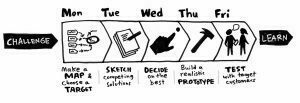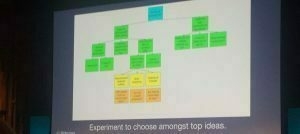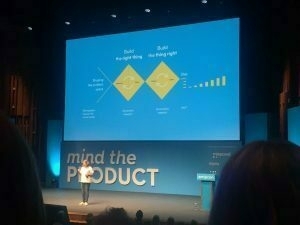Mind the Product is THE product management conference. I went to the event in London on September 8th 2017 together with my colleague William Penhallurick at The Stars Group. This post recaps what we have learned.
Product management isn’t about managing products
Product management is about managing people. To be successful everyone in the ream needs to own the product together and collaboratively work on it at all stages of the product development process and not just as a a check-box activity. Great people make great products and great people come from working together.Watch the elbow, don’t focus on the hand to high-five
Try it yourself: If you want to high-five someone then your chance of perfecting it is higher if you watch the elbow of the other person rather than the hand. That’s already very helpful advise of course but it also relates to product management. Jake Knapp, author of New York Times Bestseller book called “Sprint: How To Solve Big Problems and Test New Ideas in Just Five Days” showed us a process that’s applicable even to as big of an organisation as we are that lets small, committed teams get to solutions quicker:It requires the team that should contain at least a developer, a UX designer and a product manager to clear out their calendar for the whole week and sit together in a room without other distractions. It solves one problem quickly rather than multiple problems over a long period of time.
Besides the process there were a couple of interesting ‘fixes’ Jake mentioned:
- Detailed ideas from individuals over brainstorming in the group –> fewer solutions but each one is opinionated, unique, and highly detailed.
- Ideas stand on their own (on a poster) rather than being presented to not let personality outshine the content.
- Opinionated decisions over groupthinking - Decisions should be made by a decider (ideally a high ranked decision maker) to avoid blurry compromises and support transparency.
- Actual results over no results - the process requires to come up with a prototype (faking it with powerpoint, paper drawings etc. is totally fine) every time instead of just a pile of ideas.
- Talk to customers to validate assumptions. Talking to customers without the final product always feels uncomfortable but it’s worth it.
**Action Item: Test the Sprint approach in action: Pick a team of 3 (or more) to solve a challenge and dedicate a week to do it.
Watch the talk here: Design Sprints by Jake Knapp
Great products attack human needs
Blade Kelly - the Experience Strategy Lead at Sonos, a technology company that create home sound systems - says that without what he calls a ‘centreline experience’ users won’t engage with us. Creating that requires research, design and testing:|
Research - Determine how to learn about the problem |
Design - Understand the problem |
Test - Pick the interesting questions |
|---|---|---|
|
|
E.g. in this context a dashboard is a summarized display of … |
[caption id=“attachment_591” align=“aligncenter” width=“300”]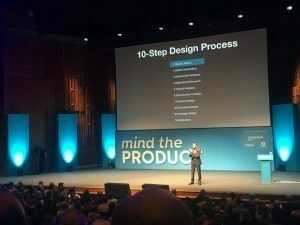 Sonos’ overall 10-Step Design Process[/caption]
Sonos’ overall 10-Step Design Process[/caption]
Compare and contrast to identify the opportunities of highest value
As product managers we often fall in love with our ideas and therefore risk to not consider enough ideas. Teresa Torres - a product discovery coach - developed an opportunity tree that helps collecting ideas to compare and contrast instead labeling them as good or bad. It’s a visual tool to identify the best areas to put our focus on while making sure we consider enough possibilities. It also provides transparency into the process and gets buy-in from the whole team.To get started she suggest the following actions to start with a clear desired outcome, map the opportunities (as a tree) and prioritize to choose what to test among the top ideas. She kindly put together a collection of resources at https://www.producttalk.org/mtpcon-london-2017/.
**Action Item: Try using the decision tree in your next product discovery exercise.
Build the right thing & build the thing right
Director of Design and UX at Moo, Jane Austin talked about integrating design into the product process. She mentioned that far too often, teams are isolated and when designers are involved, they are simply there to create a UI, outline the UX and this is then simply ‘thrown over’ to the development team to implement without the UX team truly understanding the nature of what problem they are trying to fix. Using the implementation of photo galleries at The Telegraph as an example, Jane explains how a fairly autonomous cross-functional crew sat together including- developers,
- product managers,
- UX,
- an agile coach
- and even the Telegraph CEO.
**Action Items
- Involve designers right from the beginning rather than a box to check off.
- Build fairly autonomous cross-functional crews around projects.
- Explore options to get development involved in the whole process.
Keep the weird stuff around
All masterpieces begin as experiments and it's these experiments that often look weird to most people at first. Scott Berkun, author & speaker gave an example of something that was initially considered 'weird'.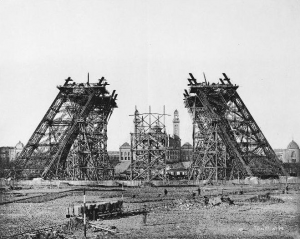 The Eiffel Tower, one of the first major structures made of iron, was heavily criticised by Gustave Eiffel's peers at the time for being unsightly, so much so that they all signed a petition to try and prevent the landmark being built. Obviously this has since gone on to become one of the world's most loved and famous landmarks! Scott's advise is to keep the weird stuff around and look at it every few days. Invite the possibility that how you look at things will be different to how others will see things.
Eventually all ideas are made of other ideas so we could look at history to find new ideas and when we pitch them internally or externally to our customers we should relate to what they know they know already e.g. when a system to message people over the internet was developed is was called 'email' as people were already familiar with how actual mail worked.
The Eiffel Tower, one of the first major structures made of iron, was heavily criticised by Gustave Eiffel's peers at the time for being unsightly, so much so that they all signed a petition to try and prevent the landmark being built. Obviously this has since gone on to become one of the world's most loved and famous landmarks! Scott's advise is to keep the weird stuff around and look at it every few days. Invite the possibility that how you look at things will be different to how others will see things.
Eventually all ideas are made of other ideas so we could look at history to find new ideas and when we pitch them internally or externally to our customers we should relate to what they know they know already e.g. when a system to message people over the internet was developed is was called 'email' as people were already familiar with how actual mail worked.
**Action Item: Next time one of your ideas results in nothing more than raised eyebrows, don't throw it away. Collect and pull it out again when it looks less weird.
Keep calm and carry on
Author Amber Case focused the majority of her talk on a CISCO report which forecasts that by 2020, there'll be 50 billion online devices in the world. We've gone from a world where it was one device for many to a world of many devices for one. In her talk, Amber highlighted the Dystopian Kitchen of the Future; a mixture of smart appliances where all appliances are running off different programming languages and different sets of protocols, all communicating differently to each other. We live in an era of interruptive technology. What we need now more than ever is calm technology.- "Technology should not need all of our attention." Every product manager should consider his his impact to the user. If an app exploits and pushes addictive behavior, it's not good for the user. The scarce resource of today's society is not technology or money, it's attention.
- "It should make the invisible, visible" Using ambient awareness, everyone is able to see the tech without it being over-whelming. Ambient awareness can be achieved through methods such as Haptics, light status or positive/negative tones (home electronics)
- "Machines shouldn't act like humans. Humans shouldn't act like machines. A person’s primary task should not be computing, but being human." The more automation we have, the more humans act like machines. The right amount of technology is the minimum amount required to solve the problem. For example, a traffic light or the “toilet occupied” light on a train.
- "Technology should consider social norms" New features, apps or devices will not be accepted if they are creepy (e.g. too much machine learning) or if it's too much at once (e.g. Google Glasses).
- "Technology should use the near and the far" Too often, apps or devices only work with a connection to the cloud. An automatic pet-feeding device that breaks apart as soon as the Wifi is down is not usable as owners can't depend their pets lives on the stability of the internet connection.
Amber talking about Calm Technology during a different conference.
**Action Item: Consider the impact of your product development to the user. Use the right amount technology to solve the problem.
Spaces shape culture
There's no doubt that spaces affect the way that we feel and the way that we work. Sarah Nelson from IBM Studios talked about how they have allowed their workforce to create their own spaces that work! However, one thing to note is that a pristine modern space does not equal a productive happy space. Providing the staff with the ability to shape their own workspace gives them a sense of belonging! 5 habits to make space work for us:- Say YES! (within HR & fire guidelines). Allow staff to do what they want.
- Prototype. Treat your office space like a product. IBM A/B tested different spaces within the office to see how people used them.
- Be Opportunistic.Take advantage of spaces that are not being used or are not being used properly and do what you want to them.
- Be Scrappy. Do things on the cheap and get creative! Murals made of post-it notes for example.
- Ask Forgiveness. Facilities managers will often say no. Get what you need by breaking the rules first. Apologies later!
**Action Item: That little seating area in the corner of your room still isn't there? Don't wait for Workplace Operations to improve your office. Build yourself.
Anticipate weirdness - Machines make mistakes
Designing products in the modern era is all about algorithms and machine learning. Big Medium founder Josh Clark pointed out that despite this, we need to be very aware that machines do make mistakes! We need to ensure that we create products that have a positive impact on people’s’ lives, rather than embed the injustices of the past. Embrace Uncertainty We need to understand that these systems only know what we tell them and if we feed them data which confirms our existing biases then they will react with the same injustices. Last December, if you asked Google Home devices if women were evil, it would reply “Yes’ followed by a thirty second explanation as to why! We need to be comfortable building machines that, when not smart enough to know the answer, don't simply guess. Saying "I don't know" is a better response than a wrong answer! Don't communicate confidence when you don't have it.**Action Item: Communicate uncertainty and don't simply label a guess as face value.
Every product team has room to improve
First things first....conflict happens in every workplace. However, it is important to remember that conflict should be an exception not a rule. If it becomes a rule, then there are problems! These are the words of Silicon Valley Product Group partner Lea Hickman. The main cause of conflict was put down to competing goals within the same organisation. For example, getting the product to market by a deadline may be the goal of the CEO. However, taking longer and getting the best product to market may be the goal of the Product Manager. To ease conflict, Business goals and Product goals should be closely aligned and done in partnership and agreed upon. In her words, “Don’t have a conversation about what you want me to do. Have a conversation with me about what you want to achieve.” As a product manager, you are the face of the product and are accountable for the success (or failure) of the product. Be accountable, don't hide away from delivering bad news. Establish trust by letting the business know what your failures are but more importantly, how you're going to address the failures. Lea also gave key skills of the type of person she would look for if she was hiring a Product Manager;- Intellectual curiosity - must be always trying to improve themselves.
- Natural collaborator - must be open, rather than trying to be right. Has to be able to work with others, but also someone others want to work with too.
- Grit - The person must have a lot of passion and perseverance.
- Shared values - they must believe the same things and feel empowered to do the job they are doing. If you have sustainable teams with same values and who feel empowered, they will deliver results.
**Action Item: Next time you find yourself in a conflict, look at the goals: Are they aligned or do they compete? Focus on what you and your counterpart want to achieve.
Create a high performing culture
Barry O'Reilly, Author & ExecCamp founder told us all about how so many organisations are set up to not perform. In-grained antiquated practices such as annual performance reviews, quarterly planning and budgeting do not allow businesses to react with the speed that’s required to operate in an efficient way. So what can we do instead? Instead we need to empower through purpose! The highest performing organisations are not motivated by money but by working towards a common goal/mission/vision that all people believe in. The highest performing companies have a culture of empowerment. Using a military analogy, Barry explained how Napoleon realized that he couldn’t write his troops a BRD before they went into battle. He had to give his people the power to make a decision.
**Action Items
- Communicate the goal/mission/vision and allow contributors make decisions on how to get there.
- Think, what's the smallest thing you can do today that can make a difference? Transform yourself, not others. Remember......Great leaders don’t have better answers, they ask better questions.
Most of the talks should be available online as a video recording by now, e.g. here you can find ‘Design Sprints’ by Jake Knapp.
Hit me up via Facebook / Linkedin / Twitter / Email or comment below.
